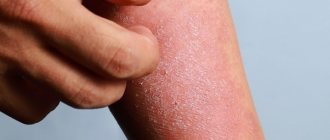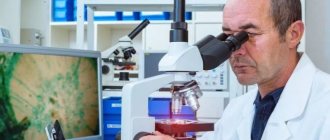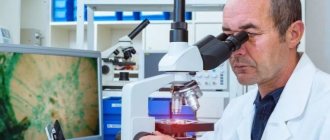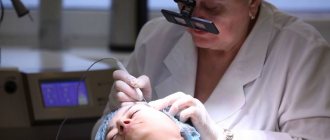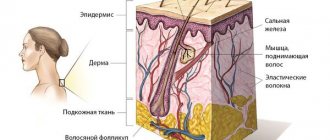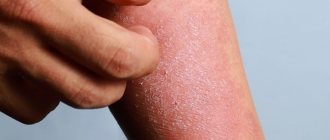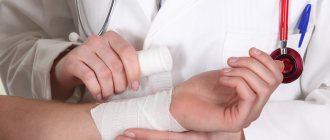August 16, 2020
Dermatitis is an inflammation of the skin that can occur due to a variety of irritants: allergens, aggressive chemicals, fungi, and adverse weather factors. Chronic inflammation of the skin also occurs with psoriasis, but in this case the condition is distinguished as a separate disease, and dermatitis is a collective concept, a syndrome that may not relate to any specific disease, occurring periodically.
Types of dermatitis
Dermatitis is classified depending on the cause of its occurrence. The following types are distinguished:
- atopic - caused by excessive sensitivity of the skin to environmental factors, the genetic nature of atopy is assumed;
- traumatic - appears as a result of mechanical trauma to the skin;
- medicinal - adverse reaction to any pharmaceutical drugs;
- thermal - burns or frostbite;
- allergic - skin reaction to any factor that leads to an increase in histamine levels;
- seborrheic - occurs in those areas of the skin that are actively supplied with sebaceous glands, manifested by the occurrence of dandruff and acne;
- herpetic dermatitis - associated with damage to the body by herpes;
- infectious, for example, scabies or lichen;
- contact - a reaction to an external irritating factor.
You may have already heard the term “contact dermatitis”. This is not a separate type, but a type of dermatitis that is caused by direct contact of the skin with a damaging factor. For example, allergic dermatitis may be contact dermatitis if you used a detergent to which your skin reacted, or it may be non-contact if the allergen was in the air or food.
Primary infection
Most cases of primary infection are asymptomatic, and clinical lesions are observed in a minority of infected individuals. After an incubation period (2–14 days), the disease manifests itself in the form of herpetic gingivostomatitis or dermatitis.
Herpetic gingivostomatitis
The most common clinical manifestation of primary HSV-1 infection is gingivostomatitis in children and young adults. Fever for 2 to 7 days, malaise, myalgia, inability to eat, irritability, and cervical adenopathy are also typical. Exudative or ulcerative pharyngitis may be present. Multiple ulcerations appear in the back of the mouth; lesions on the oral mucosa may persist for 2-3 weeks. The most common complication of infection is dehydration in children due to refusal to take fluids by mouth, which may require hospitalization. In sexually active individuals, HSV-2 can cause a primary infection in the form of oral lesions and pharyngitis, which are associated with moderate to severe pain and systemic symptoms simulating bacterial tonsillitis.
Herpetic dermatitis
The usual localization of rashes is the circumference of the mouth, especially the red border of the lips, nose. In more rare cases, the rash is located in the area of the cheeks, temples, eyelids, ears - this localization is called simple gladiator herpes (Gladiatorum Herpes Simplex Virus), as it is often found in wrestlers. The rashes are grouped hemispherical blisters against a background of erythema and edema. 1–2 days before the rash appears, patients feel a burning sensation, tingling, itching in the places where the rash will appear in the future. The contents of the vesicles are transparent, then become cloudy. Closely located bubbles can merge into a multi-chambered continuous bubble. After the bubbles open, erosions and crusts form.
The process on the skin resolves within 10–14 days. In the case of a secondary infection, relapse continues for up to 3–4 weeks.
Atypical forms of herpetic dermatitis
- Zosteriform herpes simplex is characterized by the appearance of vesicles along one or another nerve of the face, limb, or buttocks. This form differs from herpes zoster in the absence of pain radiating along the nerve.
- The abortive form occurs in areas of skin with a thickened stratum corneum on the skin of the palms and fingers. It manifests itself as barely noticeable vesiculopapular elements, accompanied by itching, burning, and pain along the nerves.
- The edematous form occurs on skin with loose subcutaneous tissue - eyelids, lips. Due to severe swelling, the primary elements are not visible.
- The elephantiasis-like form is an edematous form with the development of persistent lymphostasis in the lesion.
- The ulcerative form is characterized by the formation of small ulcers at the site of ordinary herpetic eruptions. The ulcers slowly increase in size and do not epithelialize for a long time. If they persist for more than 3 months, then they are classified as AIDS-marker diseases.
- The hemorrhagic form is characterized by the appearance of blisters with bloody contents; the rash can be located on any part of the skin.
- The hemorrhagic-necrotic form occurs with necrosis at the site of the rash and the formation of scars.
Complications of primary infection
Common complications of a primary infection are:
- eczema herpetiformis in atopics;
- keratoconjunctivitis;
- autoinoculation;
- dissemination of HSV infection in other skin conditions such as Darier's disease, mycosis fungoides, ichthyosis vulgaris and congenital ichthyosiform erythroderma.
Recurrent infection
Based on the natural history of HSV-1, infection is now defined as a persistent chronic infection of sensory ganglia with varying degrees of epithelial expression. Up to 40% of people infected with HSV-1 have a clinical relapse at some stage. Asymptomatic spread of HSV-1 in saliva has been reported in 1-10% of adult cases.
Factors that provoke reactivation of the virus include:
- exposure to ultraviolet radiation;
- illness with fever;
- stress;
- premenstrual tension;
- surgical procedures;
- dental surgical procedures;
- dermabrasion, including laser therapy;
- neurosurgical interventions.
Most individuals who develop a recurrent infection have a prodromal phase with sensations of burning, itching, numbness and/or pain. This phase occurs over 6-12 hours and is followed by clinical symptoms. Groups of vesicles appear on an erythematous or papular base at the junction of the skin and mucous membranes on the lips and on the internal keratinized areas of the oral cavity, such as the gums and hard palate. The ulceration phase is very short, followed by a long crusting phase with an average duration of 133 hours. The total healing time is 7-10 days.
Atypical forms of recurrent herpes infection
Patients with immunodeficiency and HSV-1 infection have an increased level of viral activation - 70-80%. In such patients, ulcerations develop primarily around the mouth and within the oral cavity, both in keratinized areas and in areas where keratinization is absent.
- Herpetic geometric glossitis
was first described in 1993 as a characteristic pattern of HSV infection of the tongue in organ transplant patients and in HIV-infected patients. - A migratory form in which during each relapse the rash is located in new areas.
Complications of orofacial recurrent HSV infection
- eczema herpetiformis;
- recurrent eczema multiforme;
- nosocomial spread of infection, including neonatal herpes;
- herpetic whitlow in dentists and other health care workers.
Perioral dermatitis: causes
Experts have not fully identified the causes of perioral dermatitis. However, it is generally accepted that this is a complex, multifactorial disease that has a wave nature (with stages of exacerbation and remission, respectively).
It is usually customary to associate the appearance of a rash around the mouth with hormonal changes that occur:
- when taking various medications, primarily when using ointments based on corticosteroids. Most often, corticosteroids are prescribed as one of the main means for the treatment of acne, rosacea, blackheads, eczema, etc. It is in the case of using corticosteroid ointment that perioral dermatitis can be detected in teenage boys;
- during pregnancy: this type of dermatitis is often diagnosed in women during pregnancy, which makes it possible to assume a hormonal origin of the disease, since pregnancy most often entails serious hormonal changes in the female body. For the same reasons, dermatitis most often worsens before the start of the menstrual cycle. Hormonal changes often occur in newborns, which fully explains the possibility of dermatitis in young children.
Among other things, such dermatitis can occur due to:
- abuse of cosmetics: most often we are talking about both decorative cosmetics (foundation and powder in the first place), and moisturizing creams, scrubs, tonics;
- using fluoride-containing pastes that can irritate the skin around the mouth;
- severe chapping of the skin, especially in the cold, as well as severe insolation (absorption of large amounts of sunlight);
- infections: often during the diagnostic process various infectious agents are discovered (streptococcus, staphylococcus, etc.), but specialists have not yet been able to identify a single agent that can cause the development of this type of dermatitis;
- failure of the immune system, which most often occurs due to a lack of vitamins in the body, especially in adolescents, who during the period of active growth experience a special need for vitamins. In this regard, it is also customary to include an imbalance of intestinal microflora, which occurs due to problems with the digestive organs, as provoking factors for dermatitis.
Perioral dermatitis: consequences
Dermatitis of this type is a very unpleasant dermatological problem, which, in the absence of timely professional intervention, can spread further over the skin of the face. In addition, usually the papules are destroyed, and in their place crusts form, the premature removal of which can cause hyperpigmentation (more intense coloring) of certain areas of the skin.
In case of large skin lesions, especially against the background of weakened immunity, including in children, purulent, weeping ulcers can form in place of papules (pimples), causing patients a lot of discomfort.
In addition, sometimes, in relatively rare cases, oral dermatitis can affect not only the area around the mouth, but also be found on the skin around the eyes, on the lower and upper eyelids. At the same time, dermatitis poses a potential danger to the patient’s vision (primarily if diagnosed in small children), and therefore requires timely consultation with an ophthalmologist
.
Treatment of Dühring's dermatitis herpetiformis
The doctor prescribing examinations, tests and treatment must be a qualified specialist in the field of dermatology.
The patient is advised to exclude cereals and iodine-containing products from the daily diet. Complex treatment includes the use of medications. Treatment in cycles of five to six days with short breaks is necessary with dapsone, DDS, sulfapyridine and other drugs of the sulfone group. In unsuccessful cases, therapy is replaced with corticosteroids.
The symptoms of the disease are treated separately: the patient is prescribed medications that reduce the sensation of itching, burning and tingling. This could be Claritin, Erius or other antihistamine medications.
To relieve the painful manifestations of Dühring's dermatitis herpetiformis, warm baths with a weak solution of potassium permanganate are prescribed.
Herpes symptoms
Labial herpes is the simplest and most harmless form of the disease, which occurs most often in children. Apart from discomfort for the baby and parents, in most cases the disease is not accompanied by serious consequences. Typical clinical picture:
- the formation of painful blisters filled with serous fluid in the lip area;
- itching and burning in places where skin elements appear;
- loss of appetite. Breasts may refuse to breastfeed due to pain during feeding;
- general weakness, lethargy, emotional lability;
- increase in body temperature to 37-37.5 ° C (rare).
With adequate treatment, signs of the disease can disappear after 3-4 days.
Chicken pox is a typical representative of “childhood infections”. The disease is accompanied by the appearance of rashes with serous contents throughout the body of a small patient. A characteristic feature that allows you to quickly differentiate chickenpox from other infectious pathologies is the obligatory presence of pustules on the scalp and the formation of crusts after removal of the blisters. The disease is also accompanied by a rise in body temperature to 38-39.5 ° C. The severity of the pathology depends on the individual characteristics of the child’s immune system and the aggressiveness of the pathogen.
Herpes zoster is accompanied by:
- the occurrence of rashes along the intercostal nerves;
- severe pain in the area where the pustules spread;
- high fever;
- pronounced general intoxication syndrome.
If you detect at least one of these symptoms, you should immediately consult a doctor. SM-Doctor specialists point out that chicken pox and herpes zoster are diseases that require isolation of a small patient in a hospital to monitor his condition and prevent the spread of the pathogen to other family members and the environment.
About the disease
Herpetic infection is a collective concept that is used to refer to diseases that are provoked by different types of the virus of the same name.
Traditionally, in pediatric practice, pathology caused by type 1 is encountered. This is the so-called labial herpes (rash on the lips). Its peculiarity is its chronic course. It is impossible to completely get rid of the pathogen. With adequate treatment of a child with symptoms of labial herpes, stable remission can be achieved. However, at this time the virus “hides” in the nerve ganglia (ganglia), where it can remain inactive for as long as desired. When favorable conditions arise (primarily decreased appetite), it is activated again. Another common form of herpes infection that can occur in children is varicella (chickenpox). The disease is provoked by the herpes virus type 3. It is important to remember that after successful recovery, the pathogen also goes into a latent form and persists in the nerve ganglia. The risk for the patient may be a reoccurrence of the infection. The type 3 virus, when reactivated, can cause herpes zoster, which is characterized by a more pronounced clinical picture with a deterioration in the child’s well-being and the appearance of rashes along the intercostal nerves.
The specialists of the SM-Doctor clinic have extensive experience in early diagnosis and treatment of all pathologies caused by herpes viruses. Doctors provide the necessary monitoring and quality treatment for children with any form of herpetic infection.
